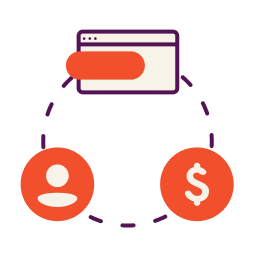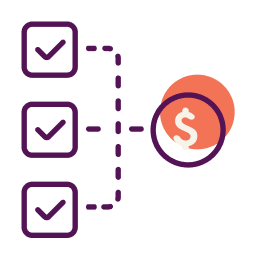Business credit scores are often seen as the number one obstacle preventing small businesses from getting financing. But disorganized financials may be equally to blame. In today’s challenging economic environment in particular, lenders want to make sure your business is viable and will be able to repay the debt. Organized and up to date finances are essential if you want to increase your chances of getting approved.
Here are 5 simple ways to organize your small business finance processes.
1. Create an Easy Filing System
“We think ignorance is bliss, but really is it filled with headaches and fear,” says Belinda Rosenblum, CPA, money strategist for business owners, and founder of OwnYourMoney.com. “Avoiding your paperwork and bills—or even a huge ‘to file pile’ is a costly recipe for disaster,” she says. “Not opening bills often causes missed deadlines or even late fees. Opening them but then letting them pile up without filing anything can cause you to feel disorganized and out of control.”
Rosenblum suggests you schedule a short block of time each week—“for example, on a Money Monday or Finances Friday.” Then “set the timer on your phone (start with 30 minutes) and focus on getting through a certain stack of paperwork.” For a simple filing system she recommends file folders for each month of the year. “Then file the paperwork based on the invoice dates for consistency. You’ll need a few other folders for items such as taxes, charitable contributions, and health insurance paperwork,” she adds.
2. Stop Mixing Personal and Business Finances
If you don’t have a business bank account, don’t put this task off any longer. (If you’re worried about the cost of a separate account, you can get a free business checking account.) Make sure to use your business account only to pay business expenses. If you need funds to pay personal expenses, pay yourself via payroll and/or owner’s draw then use your personal funds to pay personal expenses.
While you are at it, consider using a dedicated credit card for business expenses. Small business credit cards can be an excellent choice. Some business credit cards don’t report to personal credit unless you default. And most offer attractive rewards.
“Even if you do not have a business credit card, designate one of your personal cards for business expenses,” advises Sandy Smith founder, Elevate Influencer Conference. “This will make it easier to track and manage those costs. If that credit card also rewards you with mileage, cash back, or any other gift for using the card, this is an added perk that you can use for yourself as well.”
Commingling personal and business funds in your business account can jeopardize the legal protection your business structure offers. Tax time is more complicated when you don’t use separate accounts. And using personal accounts for your business can definitely make it more difficult to get financing as many lenders want to verify business revenues.
3. Plan for Expenses
You need to make sure you set aside funds to pay annual bills as well. If you don’t plan for those expenses, you may run out of money. Sylvia Inks, Business & Financial Coach at SMI Financial Coaching, LLC and author of Small Business Finance Book for the Busy Entrepreneur suggests you calculate the total financial obligations for annual bills and divide by twelve. “Then, set up automatic savings to transfer this average monthly amount from your operating expense bank account to your long-term savings bank account,” she recommends. “As yearly bills come due, you’ll have the cash ready to pay them.” Forecasting your business’s financial needs, and then planning for them is key. Many business owners outsource to finance freelancers to help with some of the more complicated planning. Software tools and websites can also help.
4. Automate It
Set up autopay for bills so you don’t forget to pay them. You’ll save money on late fees and interest charges. As an added bonus, this strategy can help you build and protect your business credit since business credit reports can include payments that are just a day late.
Consider using your credit card to make those payments and you can earn rewards. Just make it a point to pay on time to avoid interest charges.
5. Tailor Your Financial Reports
Financial reports can also play a crucial role in getting approved for financing. Traditional lenders may want to see profit and loss statements, balances sheets or other financial statements for example. Others may analyze business revenues.
But don’t create them just for lenders— use them to gain valuable insights into your own business finances. Consider creating your own “custom report” in your bookkeeping system, suggests Rosenblum. “You can choose preferences once — like not showing the pennies or comparing to past periods — and then simply choose that same report to run every month,” she explains. “Each month, instead of wondering where all the money went, you will be more likely to actually run the report and spend your time analyzing the numbers and making conscious money making moves.”
Popular Non-Traditional Financing Methods for Small Businesses
Using these methods to organize small business finance is one way to make you more attractive to lenders when you’re looking for small business loans. But there are many non-traditional financing methods for small business owners to get the right money for their business needs, especially if you have bad credit or can’t qualify for a bank loan. Depending on the loan amount, the monthly payment you can afford, and your eligibility, there are several small business financing options that may be right for you.
Online Lending
While online lenders may offer some financing products that look similar to traditional banks or credit unions, they tend to be easier to get than traditional loans. If you’re looking to found a startup or other new small business and don’t have great credit or a lot of time in business, an online lender may offer you access to financing with less strict qualifications to meet and with quicker, shorter applications and fast funding times. However, many of these products, like short-term loans or term loans, may come with higher interest rates, so make sure you do your research.
Business Lines of Credit
If you need access to financing fast, a business line of credit can give you a steady stream of money when you need it. Instead of getting a lump sum as you would with a loan, with a business line of credit, you get a spending limit, and then you only use what you need. You also only accrue interest on the amount you’ve spent and you get access to the funds again once you’ve paid. This can give the borrower more control over when and how much you borrow.
Business Credit Cards
Getting a business credit card can help you pay for everyday business expenses and help you keep your business finances separate from your personal finances (as we’ve outlined above). It can also help you free up cash flow for other expenses and give you perks like cash back, points, or other rewards.
Equipment Financing
As far as funding options go, equipment financing can be a good option for small businesses that need to get new equipment or repair existing equipment for day-to-day operations. While these loans may require a high down payment and good credit, there may be low interest rates available, and often the equipment itself serves as collateral.
Crowdfunding
Many startups and new businesses have found crowdfunding to be a great way to get working capital to launch their businesses. Equity crowdfunding can be an especially attractive way to get investors involved, although this can mean giving up some ownership of your company. Other types of crowdfunding, like rewards or donor crowdfunding, may be more suitable to your business.
Microlending or Peer to Peer
Microloans are another way that small businesses can find quick access to funding, particularly if they don’t have an established business or particularly good credit. Many microlenders loan money specifically to companies that work toward specific social causes or advocacy. As the name implies, microfinancing involves loans of less than $50,000. Some microlenders also provide small businesses with training, networking, or other resources.
Merchant Cash Advances
If you need fast access to cash for your business and don’t have great credit, a merchant cash advance (MCA) or business cash advance may be something to consider. In this situation, a lender gives you money to fund your business expenses, and you pay them back with your credit card receipts, usually at the end of every business day. Obviously your business has to accept credit cards and do a high volume of transactions with them for this to make sense for you, but it can be a way to get an injection of cash to use however you need it. But be warned: MCAs come with very high interest rates – up to 200%.
SBA Loans
The U.S. Small Business Administration (SBA) provides government-backed loan options that small businesses can use to build their companies. There are a number of SBA loans available depending on your business needs, from starting a company to commercial real estate and more. These loans are very attractive due to their low interest rates, low down payments, and great repayment terms, but they can be difficult to qualify for, especially if you don’t have a business history or good credit. We go into this in more detail below.
Grants
Small business grants are a great way for businesses to get the working capital they need. In two words, grants are free money — you don’t have to repay them and you can generally use them however you need to. Many grants are made specifically for special interest groups, such as women-owned businesses, veteran-owned businesses, or businesses that are working toward a specific social cause. The Nav Small Business Grant is offered quarterly, providing $10,000 and $5,000 respectively to a first- and second-place winner to use to build their small business.
Venture Capital or Angel Investors
Both venture capital (VC) and angel investors are popular ways to get new businesses funding from wealthy investors. While VC involves risk capital companies investing other peoples’ money, angel investors are simply wealthy individuals willing to invest their own money in ideas they believe in. Most VC and angel investing is for startups, but you may find investors depending on your business plan.
Government SBA Financing Options
The SBA helps small businesses get funding by guaranteeing the loan made by a participating lender, usually traditional financial institutions like banks or credit unions. The Disaster Loan program helps small businesses in dire need, but there are a number of other SBA loans that help small businesses get established or expand. They all offer excellent interest rates and repayment options, which is why they’re so heavily sought after.
A few popular SBA loans include:
- SBA 7(a) Loans — The most popular SBA loans allow businesses to pay for construction, renovations, expansions, purchase equipment, refinance debt, add a seasonal line of credit, or pay for inventory.
- SBA Express Loans — For a smaller loan with a fast turnaround, this includes term loans and lines of credit and can be used for the same purposes as the SBA 7(a) loan.
- SBA 504 Loans — Also known as the SBA CDC 504 Loan program, these long-term, fixed-rate loans can be used to expand or modernize your business.
- SBA Microloans — Generally made by non-profit and community-based organizations, these loans can be used for working capital, supplies, machinery, equipment, and more.
- SBA Disaster Loans — Qualified businesses can get these loans to help them recover from a federally-declared disaster.
How to Avoid Being Disqualified for SBA Small Business Financing
Yes, SBA loans are attractive and useful, but they can be hard to qualify for. A few tips to make you more attractive to SBA lenders include:
- Work on your business and personal credit, as these are the biggest indicators of your ability to repay the loan.
- Make more annual revenue to ensure you can repay the loan.
- Increase your ability to provide collateral.
- Wait until your business is older to apply, as they heavily consider your years in business as a risk factor.
- Pay off existing debt or liabilities and make sure you haven’t previously defaulted on a loan.
- Make sure you meet basic qualifications for your loan application like being in an industry approved for SBA loans and that you’re technically a “small business.”
The Easiest SBA Small Business Financing to Qualify For
Your ability to qualify for business lending from the SBA depends on your specific business, including your credit scores, time in business, and other factors, but it may be easier for you to qualify for a SBA Microloan or SBA Express Loan.
Financing your small business with loans can be overwhelming, but Nav can help you determine which type of financing is right for you and what you’re most likely to qualify for. Sign up for a free account today to start seeing your options.
This article was originally written on July 7, 2020 and updated on June 6, 2024.



Have at it! We'd love to hear from you and encourage a lively discussion among our users. Please help us keep our site clean and protect yourself. Refrain from posting overtly promotional content, and avoid disclosing personal information such as bank account or phone numbers.
Reviews Disclosure: The responses below are not provided or commissioned by the credit card, financing and service companies that appear on this site. Responses have not been reviewed, approved or otherwise endorsed by the credit card, financing and service companies and it is not their responsibility to ensure all posts and/or questions are answered.